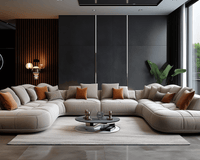Introduction
The height of a coffee table plays a crucial role in defining the aesthetics and functionality of your living space. In this comprehensive guide, we will delve into the intricacies of determining the ideal height for a coffee table, providing insights that go beyond mere measurements. Understanding the nuances of coffee table height is essential for achieving a harmonious and comfortable living environment.

Standard Coffee Table Heights
Industry Norms
- Exploring Standard Heights:Delving into the world of industry norms, we find that standard coffee table heights typically range from 16 to 18 inches. This range is carefully established to ensure functionality and aesthetic appeal across various furniture designs. By adhering to these norms, you align your coffee table with broader design principles, fostering a cohesive look within your living space.
- Influence on Design Choices: Understanding the influence of industry norms on design choices is crucial. These norms not only provide a baseline for manufacturers but also guide consumers in making informed decisions. Recognizing the prevalent standards empowers you to choose a coffee table that seamlessly integrates with other furniture pieces, contributing to a visually balanced and well-coordinated room.
- Common Furniture Dimensions:Industry norms extend beyond just coffee tables, encompassing a spectrum of common furniture dimensions. By familiarizing yourself with these dimensions, you gain insights into the broader design landscape. This knowledge aids in creating a cohesive ensemble of furniture, where each piece complements the others in terms of height, width, and depth.

Sofa Compatibility
- Analyzing Relationship with Sofa Heights:The relationship between a coffee table and sofa is pivotal to achieving a harmonious living room setup. Coffee tables are often positioned near sofas, and understanding this relationship is essential. By analyzing how the heights of these two pieces interact, you ensure that the visual flow in the room remains uninterrupted, creating a cohesive and inviting atmosphere.
- Comfortable and Visually Appealing Pairing:The ideal coffee table height in relation to the sofa is not just about numerical measurements; it's about creating a pairing that is both comfortable and visually appealing. When the heights align, it facilitates easy access to items on the table while maintaining a balanced and aesthetically pleasing look. Striking this balance ensures that your living room becomes a space where functionality and style coexist seamlessly.
- Adapting to Different Sofa Styles:Different sofa styles present varying heights, and adapting your coffee table height accordingly is key. For lower sofas, a slightly shorter table may be preferred, while higher sofas might necessitate a taller table. Adapting to different sofa styles ensures that your coffee table becomes a versatile and adaptive piece within your living space, accommodating diverse design preferences.

Ergonomics in Design
- Considering Optimal User Experience:Ergonomics plays a pivotal role in design, emphasizing the importance of considering the optimal user experience when determining coffee table height. This goes beyond aesthetics and involves creating a space that is comfortable, accessible, and functional. By considering ergonomic principles, you enhance the usability of your living space, making it a more enjoyable and user-friendly environment.
- Impact on Usability: The height of your coffee table directly impacts its usability. A well-designed table height ensures that it is easy to reach items on the table's surface, promoting convenience in daily activities. Whether you're placing a cup of coffee, a book, or decorative elements, an ergonomically sound coffee table height enhances the practicality of the space, making it more accommodating for various purposes.
- Balancing Aesthetics and Functionality:Striking a delicate balance between aesthetics and functionality is at the core of ergonomic design. The challenge is to create a visually pleasing environment while ensuring that every element serves a practical purpose. The right coffee table height contributes to this equilibrium, making your living space not just beautiful but also highly functional.
- Harmonizing with Surrounding Elements:Ergonomics in design extends beyond the coffee table itself to how it harmonizes with surrounding elements. This includes considering the height of seating, other furniture pieces, and the overall layout of the room. When all these elements are in harmony, the result is a well-balanced and comfortable living space that enhances the quality of daily living.
- In the exploration of industry norms, sofa compatibility, and ergonomics in design, we uncover the foundational principles that guide the selection of the perfect coffee table height. These considerations extend beyond mere measurements, emphasizing the importance of creating a living space that is both aesthetically pleasing and functionally efficient. Whether aligning with industry standards, ensuring compatibility with sofas, or considering ergonomic principles, the goal is to achieve a harmonious design that elevates the overall quality of your home.

Factors Influencing Coffee Table Height
Room Dimensions
- Adapting to Room Size:When considering the height of your coffee table, the dimensions of the room play a pivotal role. A crucial aspect is adapting the table height to the size of the room. In larger rooms, taller tables can create a sense of presence and fill the space effectively, while in smaller rooms, opting for a lower height can contribute to an open and airy feel. Understanding how room dimensions influence the perceived scale of the table is key to achieving a balanced and proportionate look.
- Maximizing or Minimizing Visual Impact:Coffee tables can either maximize or minimize their visual impact based on room proportions. A larger, more substantial table may be suitable for spacious rooms, making a bold statement. Conversely, in cozier settings, opting for a visually lighter or lower table helps maintain a sense of openness. Adapting the table's visual impact to the room's dimensions ensures that it becomes an integral part of the overall design rather than overpowering or getting lost in the space.
- Utilizing Height for Design Effects:Height variations in coffee tables can be strategically utilized to create specific design effects within a room. For instance, a taller table placed near a seating area can serve as a visual anchor, while a lower table can contribute to an unobstructed line of sight. Understanding how height can be leveraged to achieve design objectives allows for a nuanced approach to room layout and aesthetics.

Design Styles
- Influence on Height Choices:Design styles wield significant influence when choosing the height of your coffee table. Each design style comes with its own set of conventions and preferences regarding furniture proportions. For instance, contemporary designs often favor lower tables to create a sleek and modern look, while traditional styles may embrace taller tables for a more classic and formal ambiance. Adapting the table height to align with your chosen design style ensures a cohesive and visually pleasing interior.
- Modern vs. Traditional Considerations:The clash or harmony between modern and traditional design styles can impact your table height choices. Understanding the characteristics of each style is essential. Modern designs typically lean toward lower, streamlined tables, promoting a sense of openness. Traditional styles may call for taller tables that exude elegance and formality. Striking a balance between these design elements ensures that your coffee table becomes a seamless part of the broader interior design narrative.
- Personalizing Interior Themes: Your coffee table serves as a canvas for personal expression within your home. By choosing a height that aligns with your preferred design theme, you infuse your unique style into the overall aesthetic. Whether you lean towards minimalist, eclectic, industrial, or any other design style, the coffee table height becomes a subtle yet impactful element that contributes to the cohesive storytelling of your interior space.
- Adapting to Evolving Trends:Interior design trends are dynamic, and your choice of coffee table height can adapt to these evolving preferences. Keeping an eye on current design trends allows you to make informed decisions, ensuring that your living space remains fresh and relevant. Whether influenced by minimalist trends or a resurgence of vintage aesthetics, adapting your coffee table height lets you embrace and reflect the latest design sensibilities.

Purpose and Use:
- Tailoring Height to Functions:The purpose and use of your coffee table are instrumental in determining its height. Consider how you intend to use the table. If it's primarily for holding decorative items or serving as a visual focal point, you may opt for a height that complements these functions. On the other hand, if practicality and functionality are paramount, adjusting the height to align with everyday activities ensures that the table serves its intended purpose seamlessly.
- Decorative Element vs. Functional Piece:Understanding whether your coffee table is primarily a decorative element or a functional piece guides height decisions. For those seeking a statement piece that adds aesthetic value, a taller or uniquely shaped table may be the focus. Alternatively, if the table needs to facilitate activities like dining or working, a lower and more accessible height becomes crucial. Striking the right balance between decoration and functionality ensures that your coffee table aligns with your lifestyle needs.
- Adapting Height to Activities:Different activities around the coffee table may call for varying heights. If it's a central hub for board games or family gatherings, a lower, more accessible height is practical. For those using the table for dining purposes, a slightly taller height might be preferred. Adapting the height based on the diverse activities enhances the versatility of your coffee table, making it a dynamic and responsive piece within your living space.
- Reflecting Lifestyle Preferences:Your lifestyle preferences significantly impact how you interact with your living space. If you enjoy casual lounging and relaxed gatherings, a lower coffee table height contributes to a laid-back atmosphere. For those who prefer a more formal setting or use the table for work-related activities, a taller and more structured design may be suitable. Aligning the table height with your lifestyle preferences ensures that it seamlessly integrates into your daily routines.
- In exploring how room dimensions, design styles, and purpose and use influence coffee table height, we unravel the dynamic interplay between functional considerations and aesthetic preferences. Whether adapting to room size, aligning with design styles, or tailoring height to specific activities, each decision contributes to the overall harmony and usability of your living space. The perfect coffee table height is not just a measurement; it's a thoughtful integration of design principles and lifestyle needs.

How to Measure and Adjust Coffee Table Height
Measuring Techniques
- Step-by-step Guide:Accurate measurement is crucial when determining the height of your coffee table. Begin by measuring from the floor to the tabletop surface. Use a reliable measuring tape and ensure it is held straight for precise results. This step-by-step guide simplifies the measurement process, providing a foundation for informed decisions regarding the optimal height for your coffee table.
- Tips for Accurate Measurements:Achieving accurate measurements involves attention to detail. Ensure that the measuring tape is aligned perpendicular to the floor and that any irregularities in the floor surface are considered. By incorporating these tips, you enhance the precision of your measurements, laying the groundwork for a coffee table height that aligns seamlessly with your living space.
- Tools and Resources for DIY Adjustments: Armed with accurate measurements, the next step is considering tools and resources for potential DIY adjustments. Whether you're exploring height modification or building a custom coffee table, having the right tools, such as saws or adjustable table legs, empowers you to implement changes that cater to your specific preferences. Understanding the DIY landscape ensures that your coffee table becomes a customizable and adaptive piece within your home.

Customization Options:
- Exploring Custom-built Tables:If standard options don't quite fit your vision, exploring custom-built tables is an enticing avenue. Engaging with skilled craftsmen or furniture designers allows you to articulate your preferences regarding size, shape, and height. Custom-built tables not only cater to your unique needs but also become signature pieces that reflect your personal style within the broader design narrative of your home.
- Benefits of Personalized Height Solutions:The benefits of personalized height solutions extend beyond mere customization. By tailoring the height to your specific requirements, you create a piece of furniture that seamlessly integrates into your lifestyle and enhances the overall functionality of your living space. Personalized height solutions ensure that your coffee table is not just a standard addition but a purposeful and distinctive element within your home.
- Incorporating DIY Modifications:For the hands-on enthusiast, incorporating DIY modifications offers a creative and cost-effective route to achieving the desired coffee table height. This may involve adjusting the table legs, exploring alternative materials, or even repurposing existing furniture. DIY modifications not only provide a sense of accomplishment but also allow for a level of customization that aligns perfectly with your unique design preferences.

Visual Impact
- Enhancing Visual Appeal:Height adjustments have a direct impact on the visual appeal of your coffee table. By ensuring that the table aligns with surrounding elements, you create a cohesive and aesthetically pleasing environment. Whether it's achieving a balanced look with other furniture pieces or creating a deliberate contrast, the visual impact of the coffee table extends beyond mere functionality to become a focal point that enhances the overall design of your living space.
- Achieving Balanced and Proportional Look:The key to a visually appealing living space is achieving a balanced and proportional look. This involves considering the height of the coffee table in relation to other furniture elements. A well-balanced look ensures that the table seamlessly integrates into the room, contributing to a cohesive and harmonious aesthetic. Visual impact is not just about individual elements but the collective impression they create within the space.
- Using Height Adjustments for Creative Expression:Height adjustments provide a unique opportunity for creative expression within your home. Experimenting with different heights allows you to influence the overall atmosphere of the room. Whether it's creating visual interest through varied heights or using the coffee table as a statement piece, the ability to play with height becomes a tool for expressing your design personality and infusing character into your living space.

Conclusion:
Determining the height of a coffee table involves a thoughtful consideration of various factors, from industry standards and design styles to room dimensions and intended use. By understanding these nuances, you can make informed decisions that contribute to a cohesive and comfortable living space. Whether you opt for a standard height or explore customization options, the perfect coffee table height enhances both the visual appeal and functionality of your home. Cheers to achieving the ideal balance in your living space!

Call to Action:
Before we conclude this insightful exploration of coffee table heights, take a proactive step toward transforming your living space. Armed with the knowledge gained here, consider measuring your current coffee table, assessing its compatibility with your room, and envisioning the impact of potential height adjustments. Embrace the creative possibilities offered by customization and DIY modifications, allowing your coffee table to reflect your unique style. Remember, the perfect height is not just a measurement; it's a personalized choice that contributes to the visual harmony and functionality of your home. Seize this opportunity to curate a living space that truly resonates with your lifestyle and design preferences. Let your coffee table stand not just as a piece of furniture but as a testament to your distinctive taste and thoughtful approach to interior design.
FAQs (Frequently Asked Questions)
1. Can I use a taller coffee table with a lower sofa?
Yes, but ensure the height difference complements rather than disrupts the visual flow.
2. What's the standard height for a modern coffee table?
Modern designs often range from 14 to 18 inches, but it depends on individual preferences.
3. Should a coffee table be higher or lower than the sofa arms?
It's recommended to keep the table level with or 1-2 inches lower than the sofa arms for convenience.
4. Can I adjust the height of an existing coffee table?
Yes, explore DIY options or consult with a professional for potential adjustments.
5. How does the height of a coffee table impact the overall room design?
The right height contributes to a well-balanced and visually pleasing room design, affecting both aesthetics and functionality.
-------------------------------------------------------------
Your encouragement and support are the driving force of our creation. If you want to support us, you can pay a small amount of Bitcoin or Ethereum to the following address:
Bitcoin:
bc1q56xsdwhnva969w38808yu3erxjrxqludn9ehg9

Ethereum:
0x555C43d02140634250e965F963733Fb32F974D67














